Q is for Quesada gigas. The Quesada gigas, aka Giant Cicada, is a giant cicada with giant range, spanning South, Central and North America, reaching as far north as Texas. Read more about the Quesada gigas.
Video of a Quesada gigas song:
Q is for Quesada gigas. The Quesada gigas, aka Giant Cicada, is a giant cicada with giant range, spanning South, Central and North America, reaching as far north as Texas. Read more about the Quesada gigas.
Video of a Quesada gigas song:
The tiny Pacarina puella is an American cicada (North and Central), which is also know as the Mesquite Cicada. Here’s a photo a Pacarina puella.
Pauropsalta is a genus of Australian cicadas, once species of which is the Pauropsalta mneme, aka the Alarm Clock Ticker.
Periodical cicadas are cicadas that emerge in regular intervals of years. The most well known periodical cicadas belong to the genus Magicicada, which emerge every 17 or 13 years (depending on the species). There is also a periodical cicada in India called the Chremistica which emerges every 4 years, in-synch with the World Cup.
There’s at least 3 genus of cicadas that begin with “Platy” which means broad or flat (Greek). Not sure what that means in terms of the naming or morphology of these cicadas, but maybe someone will say why in the comments.
Platylomia is a genus of cicada that exists in Asia. Here is a photo of a Platylomia radah from Thailand (with a 5″ wingspan).
Platypleura is also a genus of cicada that exists in Asia. Here is an orange, brown and beige Platypleura mira from Thailand, and a smaller, but similarly-colored Platypleura mokensis, also from Thailand.
Platypedia putnami is a species of North American cicada (western USA) that is also know as Putnam’s Cicada. BugGuide has the best collection of Platypedia putnami photos.
The pronotum covers the dorsal area of a cicada’s thorax closest to the head. The pronotum should not be confused with the mesonotum, which covers the dorsal area of the thorax closest to the abdomen (and also features the McDonalds’ arches). Pronotum essentially means “before the back” in Greek. Mesonotum essentially means “the middle of the back”.
The pronotal collar is the area of the promotum that looks like a collar (shirt, dog). Cicada researchers use the shape and color of the pronotal collar as one way to identify a cicada’s species.
Psaltoda is a genus of cicada found in Australia. The Pasltoda moerens is a species of cicada also know as the Redeye cicada (you guessed it) because of its red eyes.
Pruinose is a white, chalky substance that appears on the bodies of cicadas and other insects. Pruinose essentially means “full of hoar frost” in Latin, which makes sense as pruinose looks like frost.
O is for ocelli. Ocelli are three jewel-like eyes situated between the two main, compound eyes of a cicada. We believe ocelli are used to detect light and darkness. Ocelli means little eyes in Latin.
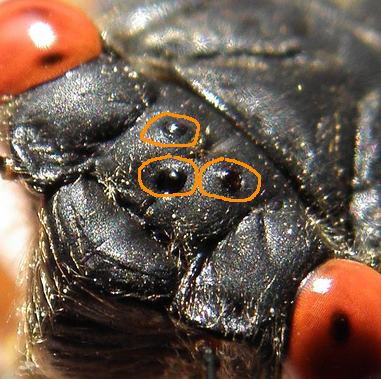
Okanagana is a genus of cicada found in North America. These cicadas are primarily black with white, beige or orange markings. Here is a photo of an Okanagana rimosa (Say’s Cicada). Here is a photo of an Okanagana bella.
Operculum means cover or lid in Latin, and the operculum covers the tympanum (which allows cicadas to hear).
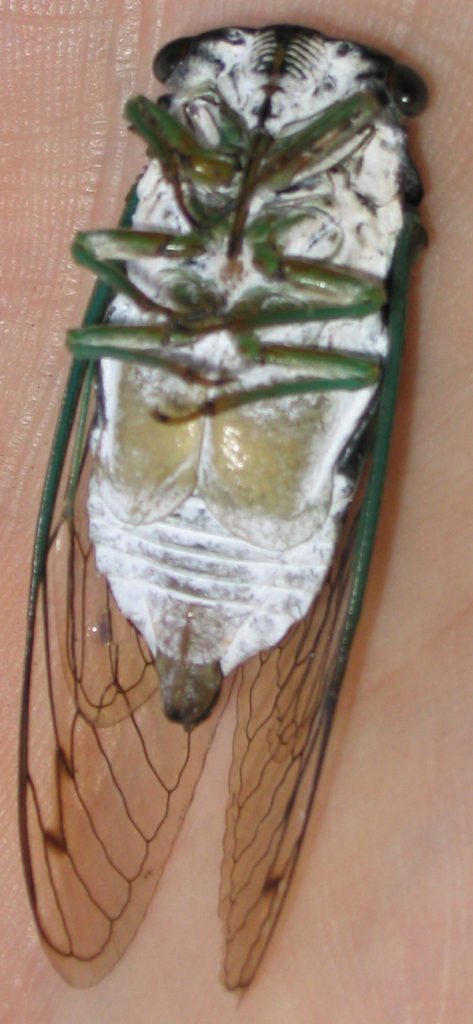
Orientopsaltria beaudouini is a medium sized cicada that can be found in Thailand. See a photo of a Orientopsaltria beaudouini:
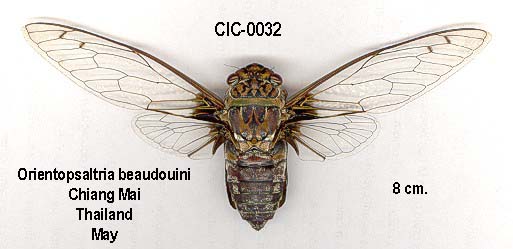
Photo by Michel Chantraine.
The female cicada uses her Ovipositor to deposit her ovum (eggs) into a tree branch.
N is for nymph. Cicadas spend most of their life in their nymph form, burrowing underground, drinking the fluids of plant roots, growing larger… waiting for the day they emerge and transform into adult cicadas. Here is a photo of a tiny 1st instar nymph, and this is a video of full-grown nymphs that have emerged from the ground:
Magicicada cicada nymph mania from Cicada Mania on Vimeo.
Neocicada hieroglyphica, which was covered in Cicada Alphabet H.
M is for Magicicada. Magicicada is a genus of North American cicadas best known for their 17 or 13 year life cycles, and for the overwhelming numbers in which they emerge. Magicicadas are organized into broods, which emerge in specific years, in specific locations in 17 or 13 year cycles. There are seven species of Magicicada, the 17 year varieties: septendecim, cassini, septendecula, and the 13 year varieties: neotredecim, tredecim, tredecassini and tredecula. Each species is slightly different in coloring, song or other attributes. Magicicada are also know as periodical cicadas and “locusts”. There’s an abundance of Magicicada photos, video and sound files on this site, and other sites like Cicadas @ UCONN (formerly Magicicada.org). Explore to find out more.
Magicicada on my finger by Dan from Cicada Mania on Vimeo.
Macrosemia is a genus of cicadas that exists in Asia. See a photo of a Macrosemia chantrainei and Macrosemia tonkiniana from Thailand.
C.L. Marlatt is best know for his study and documentation of periodical cicadas. Marlatt was an assistant entomologist working for the U.S. Dept. of Agriculture, Division of Entomology in the late 19th century when he produced the bulletin “The periodical cicada: an account of Cicada septendecim, its natural enemies and the means of preventing its injury : together with a summary of the distribution of the different broods”. You can read this document on the USDA website.
David Marshall is a cicada researcher well known for his research of cicadas of North America, Australia and New Zealand. Visit Insect Singers, David’s website; it’s packed with cicada photos and sound files, critical for identifying cicadas.
The Masked Devil is an orange and black color variation of the Cyclochila australasiae cicada found in Australia. See a picture of a Masked Devil. The green variety of this cicada is called the Green Grocer.
Massospora cicadina is a fungus that afflicts Magicicadas. The fungus is sexually transmitted, and destroys the abdomen of the afflicted cicada.
The Oncotympana maculaticollis a.k.a. Minmin-zemi is a Japanese cicada with a distinctive call, which sounds like its name: “min min minnnnnnnn”. If you’ve watched enough Japanese films or cartoons, you’ll recognize this cicada’s call. Visit the Cicadae in Japan site for photos and images.
Thomas E. Moore is a cicada researcher and curator of the University of Michigan Museum of Zoology. Visit Singing Insects of North America for cicada information collected by Moore.
L is for locusts. Locusts are not cicadas. True locusts are grasshoppers (Wikipedia page for Locust).
Locust:

17-year cicada:

People call Periodical Magicicadas locusts because they emerge in massive numbers, but they are not true locusts.
Labrum. The labrum is the structure that connects a cicada’s clypeus to their stylus. The labrum is also know as the anteclypeus.
Labium. The labium form the outside of the beak of the cicada; inside the labium is the stylet which is comprised of the mandibles and maxillae, which the cicada uses to pierce plants and drink their sap. The Latin root of both Labi and Labr is “a lip”, which makes sense when think about it.
Larvae. Cicadas larvae do not look like a grubs or maggots as you might expect; instead they look like tiny termites or ants, with 6 legs and antennae. View a video of a cicada larva.
Lembeja paradoxa, a.k.a. Bagpipe Cicada, is a cicada native to Northern Queensland Australia known for it’s massive abdomen. Here is a photo of a Lembeja paradoxa:
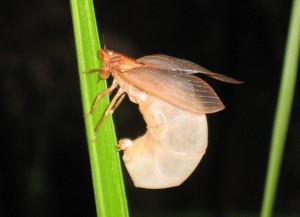
Photo by Timothy Emery.
Linne’s cicada, a.k.a. Tibicen linnei, is a cicada native to most mid-western and eastern states. View a photo of Linnie’s cicada:
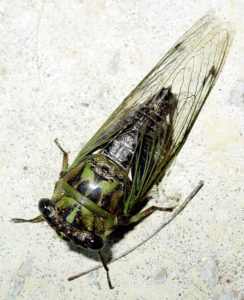
Photo by Tom Lehmkuhl.
The Lyric cicada, a.k.a. Tibicen lyricen, is a cicada native to most mid-western and eastern states (similar to the Linne’s cicada). View some photos of a the Lyric cicada:
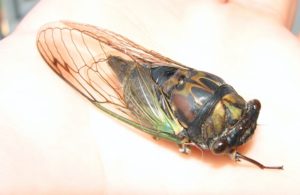
The Insect Singers website has audio files of the songs of both Linne’s cicada and the Lyric cicada.
K is for Dr. Kritsky, specifically Dr. Gene Kritsky of the College of Mount St. Joseph in Cincinnati, Ohio.
Dr. Kritsky is one of the premier Magicicada experts and advocates; if you’re a cicada fan you must attend one of his lectures and buy one of his books. A few years ago Gene provided Cicada Mania with an interview.
Kikihia, one of the two major Genus of cicadas in New Zealand. David Marshall says: “The name Kikihia is derived from the Maori word for cicada, as is the name of the town Kihikihi, in New Zealand. You’ll love their public cicada statue. See this web page: http://en.wikipedia.org/wiki/Kihikihi“.
The Kobonga is a Genus of cicadae that exists in eastern Australia. Thanks to David Marshall and Kathy Hill of InsectSingers.com for these wonderful photos of a Kobonga species currently nicknamed the Xmas Clanger (species name pending).
J is for Jar Fly. Jar Fly is a colloquial name for Tibicen cicadas.
I don’t know the origin of the term, but I’m guessing it has to do with the fact that kids keep insects in jars.
I is for instar. An instar is a developmental phase in the life of an insect. Each instar marks a change in the abilities and characteristics of the insect. Most cicadas go through five instars; the final instar of a cicada’s life is the adult or imago phase.
An imago is an adult, sexually mature insect. Here’s a photo of Magicicada imagoes:

Insectoverdin is the pigment that that makes insects like cicadas green.
H is for Hieroglyphic Cicada. The Neocicada hieroglyphica a.k.a. Hieroglyphic Cicada is found in the south-eastern United States. It’s active in the late spring and early summer. There are multiple subspecies of the Hieroglyphic Cicada including the Neocicada hieroglyphica hieroglyphica and Neocicada hieroglyphica johannis, according to InsectSingers.com.
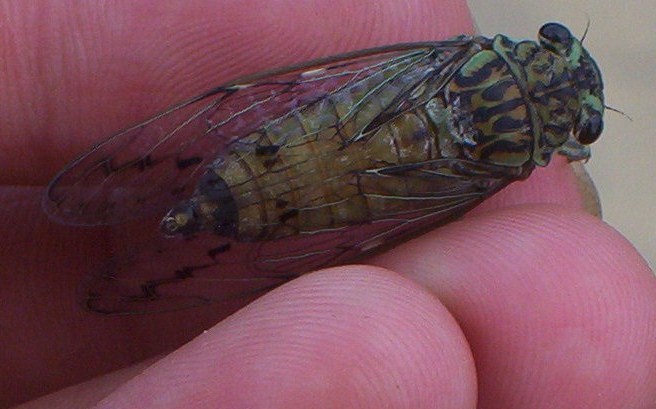
Photo by Matt Berger.
Listen to a Hieroglyphic Cicada:
Neocicada hieroglyphica singing by Joe Green from Cicada Mania on Vimeo.
 (Photo by Huechys sanguinea by =spurdog=, on Flickr).
(Photo by Huechys sanguinea by =spurdog=, on Flickr).